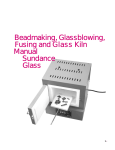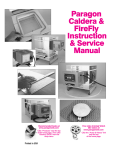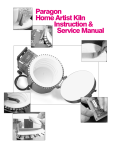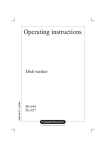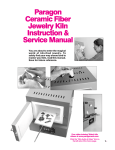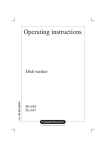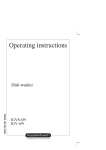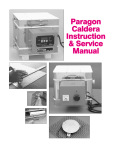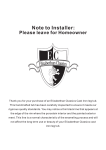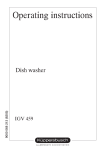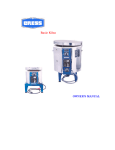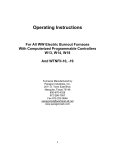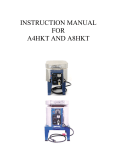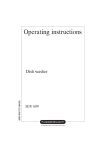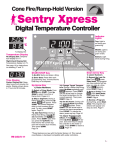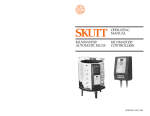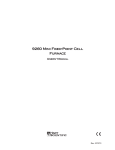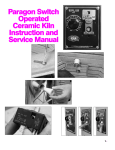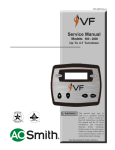Download Paragon Ceramic Fiber Jewelry Kiln Instruction & Service Manual
Transcript
Paragon Ceramic Fiber Jewelry Kiln Instruction & Service Manual 1 Introduction Thank you for choosing a Paragon kiln! We have designed it to give you many years of reliable service. Please read this manual. It will help you gain the maximum enjoyment from your kiln. It will show you how to avoid damaging the kiln and will answer many questions. Your instruction packet also includes a separate digital controller manual. Please save both manuals. Inspect the kiln. When you receive your kiln, check the carton for damage (crushed, holes, etc.). Check the kiln for both interior and exterior damage. If the kiln is damaged, you can refuse the shipment and have it returned, or accept the shipment after having the driver note the damage on the Bill of Lading. Then call Paragon at 800-876-4328 or 972-288-7557 (open Monday to Thursday, 7 a.m. to 5:30 p.m. Central). Check the Bill of Lading to insure that you received the correct number of packages. Note any shortages on the Bill of Lading, and have the driver sign the copy. If there were no signs of visible kiln damage and you discover it after the driver has left, notify the shipper immediately. Save the shipping carton. It was carefully designed to provide maximum protection during shipping. Use the carton to take the kiln to seminars or on vacation, or to return the kiln to the factory for repairs. Needless worries. Tremendous stresses are generated within the kiln. The ceramic fiber firing chamber actually expands and contracts with each firing. Do not be concerned if small cracks appear in the fiber. This is normal. These are surface cracks that close tightly when the heated fiber expands. You may find a small pin hole in the center of the firing chamber. It is from the manufacturing process and will not affect the kiln’s performance. The paint around the door will eventually discolor from heat. This, again, will not affect the kiln’s performance. During firing, you will hear an intermittent, distinct clicking. This is the sound of the relay(s) sending power to the heating elements. Do not be concerned with this sound. The Electrical data plate. Important information about your kiln is recorded on its electrical data plate. Please include this information when ordering parts or calling your dealer or the factory about your kiln. ©2001, by Paragon Industries, Inc. IM-164/1-02 2 Contents Safety 3 Setting Up the Kiln 4 Basic Operation 5 Silver & Gold Clay 8 Glass Fusing & Slumping 10 Enameling on Metal 12 Ceramic Overglaze 13 Lost Wax Burnout 14 Firing Mistakes 15 Kiln Maintenance 17 Paragon Kiln Limited Warranty 20 Electrical Installation. . . . . . . . . . . . . . . . . . 4 Where to Locate the Kiln . . . . . . . . . . . . . . 4 Transporting the Kiln . . . . . . . . . . . . . . . . . 4 Accessories . . . . . . . . . . . . . . . . . . . . . . . . 5 Important Guidelines . . . . . . . . . . . . . . . . . 5 Loading the Kiln . . . . . . . . . . . . . . . . . . . . . 7 Venting the Kiln . . . . . . . . . . . . . . . . . . . . . 8 Drying Time . . . . . . . . . . . . . . . . . . . . . . . . 8 Loading the Kiln . . . . . . . . . . . . . . . . . . . . . 8 Venting the Kiln . . . . . . . . . . . . . . . . . . . . . 9 Rate, Temperature and Hold . . . . . . . . . . . 9 Cooling Time . . . . . . . . . . . . . . . . . . . . . . . 9 Combining Silver Clay With Other Materials . . . . . . . . . . . . . . . . . . 9 How to Cut Glass . . . . . . . . . . . . . . . . . . . 10 Fusing Compatibility of Glass . . . . . . . . . . 10 The Annealing Range . . . . . . . . . . . . . . . . 10 Cleaning and Gluing the Glass . . . . . . . . . 11 Loading the Kiln . . . . . . . . . . . . . . . . . . . . 11 Firing the Glass . . . . . . . . . . . . . . . . . . . . . 11 Preparing the Copper . . . . . . . . . . . . . . . . 12 Decorating the Copper . . . . . . . . . . . . . . . 12 Firing Enamel . . . . . . . . . . . . . . . . . . . . . . 13 Pyrometric Cones . . . . . . . . . . . . . . . . . . . 13 Loading and Firing Overglaze. . . . . . . . . . 13 Overview . . . . . . . . . . . . . . . . . . . . . . . . . . 14 A Sample Program . . . . . . . . . . . . . . . . . . 14 Burnout Instructions . . . . . . . . . . . . . . . . . 15 Silver Clay . . . . . . . . . . . . . . . . . . . . . . . . . 15 Glass . . . . . . . . . . . . . . . . . . . . . . . . . . . . . 15 Ceramic Overglaze . . . . . . . . . . . . . . . . . . 16 Trouble-Shooter . . . . . . . . . . . . . . . . . . . . 17 Door Latch Adjustment . . . . . . . . . . . . . . . 17 Ceramic Fiber Repair . . . . . . . . . . . . . . . . 17 Cleaning or Replacing Glass View Port . . 17 Replacing the Thermocouple . . . . . . . . . . 18 Replacing a Relay or Transformer . . . . . . 18 Replacing the Temperature Controller . . . 19 Replacing the Firing Chamber (testing the element) . . . . . . . . . . . . . . . . . 19 Safety Important Safety Rules Overfiring The warranty on your Paragon kiln does not cover damage from overfiring, regardless of the circumstances. It is the operator’s responsibility to make sure the kiln turns off at the proper time. The Ceramic Fiber Avoid touching the firing chamber surface with sharp or pointed objects. They can damage the fiber surface. T ou c hi ng th e em bedded h eating element with sharp or pointed objects is a shock hazard. Read the Manual! Read each page of this manual in detail before operating your kiln. Warranty does not cover damage caused by failure to follow instructions. Food or Drink Surfaces Some decorative materials may be unsafe and toxic when used for surfaces that will be in contact with food or drink. Whe n y ou m ake fo o d o r drink containers, select a glaze or glass that has been formulated, tested and labeled as approved for surfaces that will be in contact with food or drink. Follow the g l az e o r gl ass m an u factu r er’s instructions exactly, without any variations. An electric kiln is extremely safe to operate provided you follow these basic safety rules: G Unplug G Do kiln when not in use. not touch hot sides. G Keep unsupervised children away. G Place kiln on a non-combustible surface. G Do not install closer than 12” from any wall or combustible surface. G Fire only in a well ventilated, covered and protected area. G Keep cordset away from hot sides of kiln. G DANGEROUS VOLTAGE: Do not touch heating elements with anything. G Disconnect G Do kiln before servicing. not leave kiln unattended while firing. G Wear safety glasses when cutting glass. G Wear firing safety glasses when looking into a hot kiln. G Keep food away from your work area. G Never fire tempered glass inside a kiln. It could explode. G Avoid firing toxic materials inside the kiln, such as styrofoam (used as a core for hollow beads). G Kilns with the glass view port: do not fire the kiln hotter than 1700°F/926°C. Firing hotter will damage the glass. 3 Setting Up the Kiln Electrical Installation You must plug your kiln into a circuit that no other appliance uses while the kiln is firing. Turn off the circuit breaker or unscrew the fuse for the circuit that your kiln will be plugged into. Check to see if other appliances shut off too. If that circuit powers appliances that must remain on while the kiln is firing, plug your kiln into a different circuit. 2 Remove gasoline, paint, and other flammable materials from the kiln room. 3 Provide a minimum of 12 inches clearance between kiln and the closest wall. 4 Never allow the room temperature of your firing room to exceed 100 - 110° F. Measure the temperature about 3 feet from the kiln. If necessary, use fans to lower room temperature. Note: 120 volt kilns: avoid extension cords if possible. If you must use one, never use one smaller than 12 gauge and longer than 20 feet. Never plug it into a ceiling outlet! Voltage fluctuation can vary firing time from as little as half to more than twice the average time. If the voltage is too low, the kiln may never reach full temperature. The receptacle must have a separate safety grounding wire. This protects you from serious electrical shock. Changing the cord plug will void your warranty! Where to Locate the Kiln 1 Place your kiln in a well ventilated, covered and protected area such as the garage, basement, utility or hobby room. Note: Some people keep their kiln outside on a covered patio. This is okay so long as the kiln is not subjected to excessive humidity. We recommend good ventilation. However, some materials, such as silver clay, may not need special ventilation. Place the kiln on a fire-proof surface, such as a large ceramic kiln shelf. 5 Keep the kiln away from curtains or other combustible materials. 6 Position kiln on a level, fire-proof surface. We recommend an 18” x 18” piece of sheet metal or a large ceramic kiln shelf. Note: If you are with the kiln at all times during firing, you can place it directly onto a workbench or kitchen table. A fire-proof surface is ideal, though, because it provides a safe place to lay hot shelves removed from the kiln. 7 Keep unsupervised children away. 8 Keep the power supply cord away from the kiln case. There is little danger of serious burn from accidental contact if you exercise the same caution you would use with an electric iron. Transporting the Kiln Some people take their kilns to seminars or on vacation. The easiest way to transport the kiln is to use the original packing materials. If you no longer have the packing materials, transport the kiln on its back with the door facing up. Place a thin sheet of foam cushioning between the door and the firing chamber to prevent rubbing. Avoid subjecting the kiln to excessive vibration during travel. 4 Basic Operation Alumina Hydrate Accessories Delicate silver or gold clay shapes may need extra support during firing to prevent warping. Place these shapes in a thin layer of alumina hydrate inside a small ceramic bisque bowl. Do not breathe alumina hydrate. Ceramic Fiber Shelves Stilts The soft ceramic fiber shelf, which comes standard with the kiln, cradles gold and silver cl a y piec e s . These shelves are not suitable for firing glass or ceramics. Stilts are points embedded in a ceramic base. The points separate enameling and glazed ceramics from the shelf. Ceramic Fireclay Shelves & Posts C eramic f ireclay shelves, available from Paragon, are hard cera mic s urf ac e s on which to fire ceramics and glass. Firing glass, enameling, and ceramic glazes directly on the firing chamber bottom would ruin the bottom. Shelves can be stacked using posts. Glass Separator & Kiln Wash Glass separator and kiln wash are mixtures of finely ground minerals that will not melt and fuse together at high temperatures. They prevent glass and ceramic glaze from sticking to fireclay shelves. The main difference between glass separator and kiln wash is that the separator is ground more finely to leave a smooth back to glass pieces laid on the shelf. As powders, glass separator and kiln wash have an unlimited shelf life. Do not breathe the powder when mixing. Caution: If glass separator or kiln wash contact a heating element, that element will burn out in the next firing. NEVER apply glass separator or kiln wash to the ceramic fiber firing chamber. The wire mesh above is referred to as an enameling rack. An enameling fork lifts the rack out of the kiln. A stilt separates the piece from the rack. Enameling Racks Enameling is the art of firing glass onto metal. The metal shapes are loaded onto a high temperature wire rack. The enameled pieces and wire rack are loaded into a hot kiln, fired for just a few minutes, and removed red hot. To load and unload the racks safely, use an enameling fork. The heating element under power is dangerous. Do not touch the element with anything! Turn the kiln switch off before inserting an enameling fork into the firing chamber. Fiber Repair Filler This is a permanent, high temperature refractory cement used to repair holes or cracks in the ceramic fiber firing chamber. Safety Glasses Wear clear safety glasses when cutting or chipping glass. Wear firing safety glasses when looking into a hot kiln, such as when checking the progress of glass. Caution: Always wear firing glasses when viewing the interior through the optional glass view port. Haik Brush The haik brush is used to apply glass separator to the kiln shelf in a smooth, thin layer. The smoother the glass separator, the smoother the underside of the glass. 5 Important Guidelines As you gain experience, you will find a wealth of information in your firing logs. The Embedded Heating Element Low Temperature Holds The heating elements of your kiln are embedded into the ceramic fiber firing chamber. The firing chamber surface is hardened to a depth of ¼”. This makes the fiber more durable. It is important that you do not touch the firing chamber with sharp objects. These can penetrate the fiber surface and contact the heating element, which is a shock hazard. Note: The heating element under power is dangerous. Do not touch the element with anything! Turn the kiln switch off before inserting an enameling fork into the firing chamber to remove a shelf. The Clicking Noise Do not be concerned if your kiln makes a clicking sound during firing. Your kiln contains a relay, which sends power to the element. The relay clicks as it cycles on and off to maintain the correct temperature. Check Thermocouple You will find a small rod, called the thermocouple, extending into the firing chamber. The digital controller senses temperature by reading a voltage from the thermocouple. If this rod is pushed out of the firing chamber, the kiln will assume that the firing chamber is cold. This will result in an over-fire. Be sure the rod extends into the firing chamber by ½” - ¾” before firing the kiln. Vacuum the Kiln Clean the kiln before firing glass, enameling, or ceramic glaze. (Cleaning is not necessary when firing silver or gold clay). Use a soft brush nozzle on a vacuum cleaner to remove dust from inside the kiln. Removing Hot Ware To remove hot ware from the kiln, turn off the kiln. Carefully slide an enameling fork under the shelf. Place the hot shelf on a large ceramic kiln shelf in front of the kiln. Wear thick work gloves. Firing Log Book Record the following information in a firing log book: I Date I Firing temperature, speed and hold; or Ramp/Hold program I Starting time I Total firing time I Type of pieces I Firing results 6 A low temperature hold (i.e. 200° - 300°F) is more difficult to maintain than higher temperature holds (1400° 1700°F). At low temperatures, turning on the heating element affects firing temperature to a larger degree than at high temperatures. When holding at a low temperature, heat the kiln slowly. Otherwise the temperature may overshoot the hold temperature before the element turns off. Avoid Contaminating the Heating Element Contact with silica or silic a b e ar in g c ompounds, such as kiln wash, glass separator, alumina hydrate, glass, enameling powder, and ceramic glaze, will ruin the heating element. Never fire glazed ceramic ware, glass, or enameling directly on the firing chamber bottom. Use a ceramic shelf on short posts to protect the bottom from glaze drips, glass and enameling powder. Caution: Some kilns contain a heating element embedded in the bottom of the firing chamber. Materials such as glass and glaze, if absorbed into the fiber firing chamber, can ruin the element. This type of damage is not covered by warranty. Prevent glass separator, kiln wash, and alumina hydrate from falling from a shelf onto the firing chamber. These materials can destroy the element. Note: If a contaminant such as dripping glass or glaze embeds into the firing chamber, unplug the kiln. Gently scrape off the contaminant with a knife, being careful not to damage the heating element. Vacuum the kiln. The Effect of Silver Residue on Glass Firing silver clay leaves traces of silver in the pores of the firing chamber. Sometimes there is enough silver residue in the kiln to affect colors of glass. For instance, green might turn yellow. Note: Before firing an important glass piece in a kiln used for silver clay, perform color tests. Fire small samples of each glass color on a base sheet of clear glass. Place the glass on a fireclay shelf (not the soft fiber shelf). The Optional Glass View Port Caution: Wear firing safety glasses whenever looking into the optional view port. Maximum temperature for a kiln with view port is 1700°F/926°C. Firing hotter will damage the glass. See page 17 for glass port maintenance instructions. Loading the Kiln Place Ware on a Protective Shelf Always protect the firing chamber by firing your pieces on a shelf or in a bowl. Do not place the pieces directly on the bottom of the firing chamber. Types of shelves and containers: Fiber Shelf Place the standard fiber shelf directly onto the kiln bottom. This shelf is used to support silver and gold clay. Note: Fire only silver or gold clay on the fiber shelf—never ceramics, enameling or glass. Do not coat the fiber shelf with glass separator or kiln wash. Fireclay Shelf Ce ra mic f ireclay shelves, available from Paragon, protect the firing chamber bottom and provide a smooth surface. Use a ceramic shelf in your jewelry kiln to fire ceramics, glass, and enameling. Insulating Firebrick Piece Insulating firebricks are porous, light-weight, and can be shaped to support delicate silver clay designs. Carve the firebrick with a knife or hacksaw. Ceramic Bowl You can purchase an unglazed, small ceramic bisque bowl from a ceramic supply store. The bowl will last through many firings. Use it to hold alumina hydrate. You can also shape hot glass by slumping it into the bowl. Note: Ceramic shelves and bowls and insulating firebricks may slow the firing. They absorb more heat than the ceramic fiber shelf. They also cool more slowly than the fiber shelf. Applying Glass Separator or Kiln Wash Glass and ceramics are fired on a fireclay kiln shelf and not directly on the kiln bottom. You can also slump glass over a mold, such as a bowl. The kiln shelf and sagging mold must be coated with glass separator to keep glass or ceramic glaze from sticking to them. A coat of glass separator or kiln wash will usually last through several firings. When the shelf coating begins to crack or chip, apply a fresh coat. When recoating a shelf, remove most of the old coating Separator lasts through several with grit cloth (available from glass firings. Apply new separator Paragon). This is an abra- when the old coat begins to flake. sive-coated mesh that allows residue to pass through. Removing the old coating gives you a smooth surface to start with. Then recoat the shelf using the following directions. (Both glass separator and kiln wash will be referred to as “separator.”) Caution: Do not apply glass separator or kiln wash to the ceramic fiber firing chamber or to the bottom of the shelf! Contact with glass separator or kiln wash can ruin the embedded heating element. Note: Do not coat the soft ceramic fiber shelf with separator. If you are firing only silver or gold clay, you do not need separator. When firing silver clay with glass, however, fire the piece on a hard fireclay shelf coated with separator. 1 Mix the separator with water following the directions on the bag. Stir. 2 Use a haik brush or a soft paint brush to apply the separator to the shelf. (The haik brush is easier to use because it lays down a more even coating.) Each time you dip your brush into the separator mixture, swirl the brush around the bottom of the container. This is because the separator settles quickly. Use two or three thin coats changing the direction of the brush stroke 90° with each coat. 3 Dry the shelf before firing. To speed drying, place the shelf on three ½” posts inside the kiln. Heat at full rate to 300°F/148°C and hold for five minutes. Then turn off the kiln and leave the shelf inside. 7 4 After the separator has dried and your shelf is cool, you can smoothen the separator further by rubbing your hand lightly over the shelf. The smoother the separator, the smoother the back side of the glass. A coat of glass separator will usually last several firings. The lower the fusing temperature, the more firings you can get from one application of separator. Using Ceramic Fireclay Posts Ceramic posts support ceramic fireclay shelves inside a kiln. I Do not use posts under the ceramic fiber soft shelf. Place the fiber shelf directly onto the bottom of the firing chamber. I Place three ½” posts under the ceramic hard fireclay shelf. This aids air circulation, preventing heat built-up under the shelf. I You can fire two or more ceramic fireclay shelves in a Paragon jewelry kiln. Support the bottom shelf on three ½” posts. Separate the shelves with taller posts. The length of the posts and the number of shelves you can fire depends on the size of the kiln. When you load multiple shelves, fire at a slower rate. This aids heat distribution. Silver & Gold Clay With silver clay, it is possible to shape intricate, free-form silver jewelry in minutes—even as a beginner. (The clay is also available in gold; for simplicity we will refer to both metals as “silver clay.”) At the time of printing, the silver clay brands available were Art Clay Silver and Precious Metals Clay. Silver clay looks and feels like modeling clay. It is formed with simple tools such as a tooth pick, small knife, and razor blade. Its surface is pliable and accepts impressions from objects such as leaves, coins, and coarse fabrics. After the silver clay is formed, it is fired in a kiln. The recommended temperature and hold time is included with the silver clay. Forming and firing silver clay is simple. There is nothing mysterious about making silver clay jewelry. The silver clay is made of micron-size silver (or gold) particles held in an organic binder. During firing, the binder burns away. The silver particles then fuse together forming real silver. Since the binder disappears, there is a certain amount of shrinkage during firing. Shrinkage varies depending on the type of silver clay you use. Drying Time Small, thin silver clay pieces can be placed into the kiln while still moist, and fired. Thicker pieces need time to dry. Otherwise they may warp during firing. To be on the safe side, give the silver clay plenty of time to dry. As you gain experience, you will know just how much drying time each type of piece needs. You can speed drying with a hair dryer. Venting the Kiln Some types of ware, such as glass and ceramics, contain impurities that burn off during firing. These impurities must be released from the kiln. Otherwise they can affect the quality of the ware. Silver and gold clay need no venting unless you are firing them with a material that burns out for a hollow shape, or you are combining them with another material such as glass. If the kiln has a vent hole, open the vent. If it does not have a vent hole, open the door about ½”. Venting will be explained in greater detail in sections on glass and ceramics. Loading the Kiln Silver clay pieces that have a flat side can be placed inside the kiln directly onto a shelf. Use the soft ceramic fiber type shelf. It cushions the clay silver. I Silver clay pieces can be close together, but they must not touch. I The soft ceramic fiber shelf can be placed directly onto the firing chamber bottom. It is not necessary to support the fiber shelf with posts, since the heat transfers easily through the fiber shelf. I Do not coat the ceramic fiber shelf with kiln wash or glass separator. I You can also place the silver clay on a piece of ceramic fiber batting. Alumina Hydrate Rounded, hollow, or other delicate shapes may need support to prevent collapsing. You can lay these pieces onto a mound of alumina hydrate. 8 If the piece needs only shallow support of ¼” depth or less, pour the alumina hydrate onto a ceramic fireclay shelf. Support the fireclay shelf on three ½” posts to aid heat flow under the shelf. combination, eliminating the need to visually check the glass. If the silver clay shape needs deeper support, pour the alumina hydrate into an unglazed ceramic bisque bowl. These are available at ceramic supply stores. I Place the ceramic bowl directly onto the kiln bottom. I NEVER use a glazed bowl to hold the alumina hydrate. If the glaze runs, it can embed into the firing chamber. Caution: Avoid breathing alumina hydrate dust. Caution: Alumina hydrate can destroy the heating element on contact. If it spills onto the firing chamber, remove with a vacuum cleaner. Venting the Kiln Silver clay by itself needs no venting. Load the kiln, close the door, and leave it closed until the clay silver is ready to remove. The kiln needs venting if you fire ceramics or glass with the clay silver, or if you make hollow objects that contain a core of organic materials. Paper maché and paper clay are good core materials. Do not use wax or styrofoam as a core. They emit harmful fumes. Rate, Temperature, Hold Each brand of silver clay fires to a specific temperature and hold time. This information is available from your silver clay supplier. Note: Hold time is the length of time that the recommended temperature is maintained in the kiln. Do not fire longer than the recommended hold, or the silver will begin to overfire. Besides selecting a temperature and hold time on your kiln’s digital controller, you will also need a firing rate. (See the separate digital controller instruction booklet.) Select a Full Power rate if you are firing silver clay alone. If you fire glass or ceramics with the silver clay, select a rate best suited for the glass or ceramics. Note: Do not place silver clay into a kiln that is already hot unless the clay is completely dry. The kiln should be no hotter than 500°F/260°C when inserting the silver clay. After the kiln begins firing, leave the door closed. Do not open the door until it is time to remove the clay. Visual inspection of the clay is unnecessary. If you are firing glass with the silver clay, on the other hand, you may need to check the fusing progress of the glass by opening the door ½” and looking inside. Look for just a second or two. As you gain experience, you will be able to program the correct temperature for the silver clay and glass Cooling Time After the clay silver has fired to completion, you can crack the door an inch to speed cooling. If you are firing stones, glass, or other materials with the silver clay, it is safer to allow the kiln to cool slowly with door closed. Remove the piece when the kiln reaches room temperature. Silver clay pieces that contain no other materials can be removed from the kiln at 1100°F/593°C. You can remove them with tongs and drop them into water. Caution: Turn the kiln off before inserting tongs into the firing chamber. Wear protective gloves. Combining Silver Clay With Other Materials There are two ways to fire silver clay with other materials such as glass: I Fire the silver clay first by itself. After you have cleaned and polished the silver clay, fire it a second time with the other material. I Fire the silver clay and other materials, such as a stone, together in a single firing. Enameling powder is easier to fire with the silver clay in a second firing. See page 12. Glass is often fired with the silver clay in a single firing. Many types of glass will melt to the point of overfire at silver clay temperatures. So before combining glass and silver clay in a single firing, test a small sample of the glass. To do this, fire the glass during a silver clay firing, keeping the glass separate from the silver clay piece. (This way you won’t ruin the silver clay piece.) Place the glass pieces on a ceramic fireclay shelf. You must coat the shelf with glass separator, or otherwise the glass sample with embed into the shelf. If the glass sample survives the firing, you can fire that type of glass with silver clay in a single firing. Note, however, that different types of glass fire to different temperatures. Every time you fire a different type of glass, be sure to test. 9 Glass Fusing & Slumping You will probably fire mostly stained glass, but you can also fire standard float (window) glass. Some types of float glass devitrify (form a dull, frosty surface) when fired. Caution: Never fire tempered glass. It could explode if heated inside a kiln. Basic Glass Tools Reservoir Glass Cutter uses a reservoir of oil to lubricate the cutter wheel. Running Pliers are for cutting large pieces of glass. Breaking Pliers are for cutting small strips. Grozing Pliers shape the glass by chipping away the edges. They are often used when the score line doesn’t break cleanly. Note that rough edges will become smooth when fired to fusing temperature. How to Cut Glass Note: IMPORTANT! Wear safety glasses when cutting or chipping glass. 1 Lay the glass on a clean surface. Mark off the cut with a grease pencil or felt-tip pen. A small mark on each end of the glass will do. Lay a wooden straight edge over the glass and line it up with the marks you just made. 2 Hold the straight edge firmly and score the glass with the glass cutter. Press just hard enough so that the scoring noise sounds steady and unbroken. 3 Place the straight edge under the glass so that an edge is lined up with the score line you just made. Press down on the glass. It will break cleanly. Fusing Compatibility of Glass When glass changes temperature, it expands and contracts. The rate at which glass changes size is called the coefficient of thermal expansion. If you fuse two glass pieces together and one changes size faster or slower than the other, the fused piece may crack—even several months after fusing. When different glasses have a close enough coefficient of expansion to fuse successfully, they’re called fusing compatible. Buy glass labeled fusing compatible. Or fuse glass that has been cut from the same sheet, which guarantees compatibility. Fusing Compatibility Test 1 To test glass for compatibility, fuse small ½” square sample pieces of different glasses onto a larger base piece of clear transparent. It should extend beyond the small sample pieces by half an inch on each side. One of the sample pieces should be cut from the base piece. 2 Heat the glass to a temperature that completely rounds the edges of the small sample pieces. 3 After the glass cools, place a polarizing filter under the glass and another filter over the glass. Look at the glass with light shining through it (hold it over a lamp). Turn one of the filters until the filters are at their darkest. Results of the Test If you see a halo around the edges of the small glass samples, this usually means the glass is not compatible. If you see no halo, the glass is fusing compatible. Why did we include a sample square cut from the base transparent glass? It tests for annealing. A halo around that piece means the glass was not annealed properly. Perform the test again, this time cooling more slowly through the annealing range. The Annealing Range Each type of glass has a temperature range that it must pass through slowly when it cools. This is called the annealing range. This slow cooling gives hot glass time to release the stress of cooling. If you cool the glass too fast through the annealing range, it will break. The larger and thicker the glass, the slower it must pass through its annealing range. You cannot over-anneal, so err 10 on the side of caution if you aren’t sure how long to anneal. Small projects such as earrings rarely need annealing time as they cool. Cleaning and Gluing the Glass Grease, dirt, and fingerprints etch permanently into the glass during firing. Clean the glass with glass cleaner (the type without silicones), rubbing alcohol, or even plain water just before assembling the pieces on the kiln shelf. Use white glue, suc h a s Elmer’s diluted 1:1 with water, t o hold the glass pieces together after you place them on the kiln shelf. Use the glue sparingly. Glue is especially important when fusing wire into the glass. The glue prevents the glass or wire from moving out of place before they fuse. The glue disappears during firing. Avoid using glue on the coated side of dichroic glass. If you lay dichroic glass carefully onto the piece, glue is unnecessary, so avoid it altogether if you do not know which side of the dichroic is coated. Loading the Kiln Air should circulate between the shelf and the bottom of the kiln, so place three or four 1/2” posts in the kiln. Lay the shelf over the posts. Firing the Glass 1 Vent kiln by opening the door ½” and leaving the vent hole (if your kiln has one) open. Venting allows the gases released to escape. When the kiln reaches 500 800° F / 260 - 426°C, close the door. 2 The first time you fire a particular brand or type of glass, program the controller for a higher tempera- Looking at the glass during firing. Open the door about ½”. Always wear firing safety glasses when looking at the hot glass. ture than the estimated fusing temperature. Watch the glass by opening the door ½” for several seconds at a time. Shut the kiln off when the glass fuses the way you want. Make a note of the shut-off temperature. For future firings, program the kiln for that temperature and rate. Note: With every firing, be sure you are near the kiln before the expected shut-off time. 3 After you shut the kiln off, vent the kiln for five minutes by opening the door 1”. Then close the door. Note: Some glass artists flash cool the glass after it fuses. They vent the kiln until the temperature drops to 1000° F. Then they close the door again. This speeds up cooling. 4 The annealing range for most glasses is between 950°/510°C and 700°F/371°C. Cool slowly through this annealing range. Leaving the door closed will slow the cooling enough for most projects. If you need even slower cooling, program a separate segment for cooling. See the kiln’s digital controller manual. Note: For safest cooling, leave the ware inside the kiln until the kiln reaches room temperature. If you remove the ware too soon, the sudden temperature change can crack the piece. To remove small pieces, such as glass jewelry, before they have cooled completely, remove the shelf also. Leave the pieces on the shelf until they reach room temperature. The heat in the shelf will help prevent them from cooling too quickly. Caution: Before removing a shelf, turn off power to the kiln. 11 Enameling on Metal Preparing the Copper Enamels come in transparent or opaque. They can be purchased directly from Thompson Enamel, P.O. Box 310, Newport, Kentucky 41072. Their Lead Free Enamels come ready to use. No enamel washing is required for these enamels. Start with one of the many pre-shaped copper forms available, or shape and trim the copper to your own design. Decorating the Copper Counter Enameling Most enameled pieces should be counter enameled on the back side. This gives the piece a much more finished look, it eliminates a great deal of fire-scale cleaning, and it controls the chipping and cracking that can result from the different rates of expansion and contraction in copper and enamel after the enamel has been fired. Counter or backing enamel, a mixture that gives a mottled effect, can be used for counter enameling. Or you can use regular enamel. Counter enamel is applied by the sifting method described below. 1 Heat the copper on an enameling rack to about 1400°F/760°C to burn off oil or grease. Heat the copper to just until smoke from oil or grease stops coming off the metal and its color has changed to a purple-red-pale green iridescence that moves across the copper. This indicates that the grease has vaporized. Do not fire the copper any longer than this point. Otherwise excess fire scale will form, making the next cleaning step difficult. 2 After the copper cools, brush any loose scale from the copper. Use a brush or paper towel, being sure that you do not put any grease or oil onto the copper, When firing counter enamel, underfire it so that the fire scale on the front of the piece isn’t too difficult to remove. You can purchase a masking preparation from your supplier to help prevent fire scale. You must place the piece on a stilt when firing the other (front) side of the piece. The stilt prevents the back of the counter enameled piece from sticking to the enameling rack. Applying Enamels Apply enamel over a clean sheet of paper so you can pour the excess back into the bottle for reuse. Transparent enamels should be applied in several thin coats. Transparent enamels can be mixed with fairly good results. If opaque enamels are mixed, however, a grainy effect results. The two basic methods of applying enamels are sifting and spatula. Sifting Enamel such as fingerprints. Clean the copper with a 3M Scotch-Brite® pad. This pad does such a good job that in most cases no further cleaning will be required. Additional copper cleaning products are available in the Thompson Enamel Catalog, including Sparex No. 2. It is best to clean the copper just before you decorate it. If you wait too long to decorate after cleaning, the copper could get dirty again. 12 Spray or brush Thompson holding agent onto the copper. Then sift a 1/32” layer of enamel onto the copper. Use a #60 mesh sifter. If the coat is too thin, you can easily add another coat after firing. But a coat that is too thick will bubble and crack. The enamel must dry completely before firing. Spatula or Inlaid Method You can use this method to decorate a small area with many different colors. Using a diluted solution of Thompson holding agent, dampen the enamels just to the saturation point, and maintain this moisture while working with the enamels. Apply the enamels onto the copper with a small spatula, and spread them out with a spreader to a coat of about 1/32” thick. Lines of contact can be formed by the spatula blade. Then spray the enamels with the holding agent to keep the grains of enamel in place. Allow the enamel to dry completely before firing. Firing Enamel 1 Heat the kiln to 1450°F/787°C for most enameling. Use a Single Segment. (Please see your digital controller instruction manual.) Segment 1 Rate °F/°C Temp. °F/°C Hold 1799/999 1450/787 01.00 Note: Hold time should be the length of time you will be inserting enameling into the kiln. In the above example, hold time is for a one hour. 2 Lay the copper shape on an enameling rack. If the part that touches the rack is enameled, place a stilt under the copper. Some bowls or other shapes have enameled sides that might run during firing. These should be fired with a stilt even if the piece has a plain bottom. Use an enameling fork or, if the rack is small, a 6” putty knife, to place the rack into the kiln on top of ½” ceramic posts. Note: Firing the piece at enameling temperature should take about three minutes and requires undivided attention! 3 Look at your piece every 15 seconds by cracking open the door. Remove the rack when the copper piece appears a rosy red and the enamel is smooth. Place the rack on a steel pad or large ceramic kiln shelf and let it cool completely. 4 After counter enameling, you will need to clean the fire scale off the front of the piece. A 3M Scotch Brite® pad works well for this. Then clean it with Thompson Sparex No. 2. Ceramic Overglaze Pyrometric Cones Pyrometric cones are small pyramids of clay and mineral oxide that soften and bend when exposed to heat. They indicate when ceramic ware has fired to maturity. Pyrometric cones come in 1 1/8" and 2 ½" lengths. Use the 2½” cones. Cones mounted on the kiln shelf must be slanted 8° from vertical. They will not bend accurately if they are slanted t o t h e wr on g an gle . S e lf - su ppor t in g lar ge cones have the correct slant built into the base. Stand ar d c on e s mu st b e mounted in a clay or wire plaque. The chart on page 14 shows the temperatures of pyrometric cones. Program your controller to the cone recommended for the ceramic ware that you are firing. F or small c e r amic pieces, such as figurines, pr ogr am a r at e of 400°F/222°C. Fire to the temperature shown in the 108°F column of the Temperature Equivalents chart for the cone number you are firing. A self-supporting cone fired to maturity. Do not be concerned if the tip is slightly higher or lower than shown. A “puddled” over-fired cone. Under-fired cone. Before deciding on the firing speed of important pieces, test fire sample clay pieces. Note: Do not fire beyond your kiln’s maximum temperature. Firing hotter will void your warranty. Kilns with glass view port: do not fire hotter than 1700°F/926°C. Loading and Firing Overglaze Overglaze is decoration applied over fired glaze or polished porcelain bisque. Overglazes include china paints, gold, and luster, which fire from cone 022 to 014. Load overglazed ware the same way you would load ceramic glaze. Use stilts and make sure ware is not touching other ware. Ware must be completely dry before firing. 13 China paints will crack or peel if applied heavily. Apply several light coats instead, firing between each, until you get the shade you want. Not all china paint colors r e a ch max imum color saturation at the same temperature even when fired on the same ware. So you Open the door ½” to vent the kiln if your kiln must know which col- does not have vent holes. ors you should fire first at higher temperatures to prevent burning out the original colors in later firings. For example, reds mature at a lower temperature than other colors and are fired after the other colors have been fired. Reds and yellows should not be fired side by side. Colors also mature at a lower temperature on ceramic pieces than on porcelain or hard china. Check the overglaze manufacturer’s literature for information on which cone to use with each color and type of ware. Vent the door during the first hour of firing. If your kiln has a vent hole, leave it open during the entire firing. Allow kiln to cool to room temperature before opening the door. Temperature Equivalents For Orton Self-Supporting Pyrometric Cones Cone Number Heated at: Self-Supporting Cones 27° F 108° F 270° F Per Hour* Per Hour* Per Hour* Cone Pre-Fire Color Caution: Only kilns with vent holes are designed for lost wax burnout. However, you can use a kiln without the vent hole provided that you open the door ½” during venting. Caution: Always use a wax tray. Caution: If your kiln’s heating element is embedded in the floor of the firing chamber, place the metal wax tray on 3 or 4 - ½” posts inside the kiln. This prevents the element from possibly shorting out against the tray. Note: These instructions apply to injection wax that melts at 200°F, not pattern waxes and plastics that melt at higher temperatures. If smoke appears during wax elimination, turn off the kiln. Smoking wax means the kiln fired hotter than 300°/148°C. Overview Lost wax casting is the process of carving a shape in wax , and then casting that shape in metal. After the wax has been carved, a mold is made of the wax shape. The mold is a negative image of the wax. The wax is later melted out of the mold through hollow channels called sprues. Lost wax burnout is the process of preparing a casting mold for the melted metal that will be poured into it. The steps in lost wax burnout: 1 Melt the wax from the mold. 2 Remove wax from the kiln before raising the temperature higher than 300°F/148°C. 3 Harden the mold at high temperature. 022 — 1087 1094 Green 021 — 1112 1143 Fuschia 020 — 1159 1180 Orange 019 1213 1252 1283 Yellow 018 1267 1319 1353 White 017 1301 1360 1405 Pink 016 1368 1422 1465 Light Blue 015 1382 1456 1504 Violet 014 1395 1485 1540 Gray 013 1485 1539 1582 Green 012 1549 1582 1620 Fuschia *Rate of temperature increase during last 90 - 120 minutes of firing. Tables by courtesy of the Edward Orton, Jr. Ceramic Foundation. 14 Lost Wax Burnout 4 Maintain the mold at the casting temperature recommended for the type of metal that will be poured into the mold. Caution: Prevent wax or carbon from contacting the kiln’s walls and elements. Carbon build-up inside a kiln ruins the interior. Carbon conducts electricity and causes elements to short circuit. Damage to elements from contact with foreign materials is not covered by warranty. A Sample Program See your digital controller instruction manual to enter this program: Rate °F/°C Temp. °F/°C Hold 1 500/277 300/148 01.00 2 500/277 1350/732 01.00 3 450/250 800/426 02.00 Segment Segment 1 heats the wax to 300°F/148°C and holds it for one hour, allowing it to drip from the mold. Segment 2 hardens the mold. Segment 3 lowers temperature to 800°F/426°C, the typical casting temperature for silver. (Most types of gold cast at 900°F/482°C.) Note: Casting temperature depends on the size of the mold. The temperatures above are only a guide. See your jewelry supply dealer for temperature recommendations. Burnout Instructions 1 Place a metal tray inside the kiln on three ½” posts. Place the mold on a wire mesh screen on top of the tray. The mold’s sprue hole should be down. The tray will catch melting wax as it drips from the sprue hole. 2 Keep the kiln’s vent hole(s), if any, open during wax elimination. If the kiln has no vent hole, leave the door open ½”. This allows fumes to escape from the kiln. Heat the kiln to 300°F/148°C and hold it at that temperature for at least one hour. Note: Do NOT heat the wax above 300°F/148°C. Hold at 300°F/148°C for at least one hour. During this hour, the wax will melt from the mold and drip into the tray. If the kiln gets hotter than 300°F/148°C, the wax may smoke and deposit carbon inside your kiln, causing expensive damage. 3 After one hour at 300°F/148°C, open the kiln. Remove the mold and wax tray. Pour the wax from the tray and leave the tray out of the kiln until your next wax elimination. (Do not leave the tray in the kiln!) 4 Heat the mold to the temperature recommended by your jewelers’ supply house where you purchased the mold material. This is usually around 1350°F/732°C. 5 Lower the temperature to the casting temperature of the metal. Hold at that temperature until you are ready to begin casting. Remove the mold with tongs. Wear protective gloves and safety glasses. Saving a Carbon-Damaged Kiln If you follow the above directions, your kiln should be safe from wax damage. In some cases, a small amount of carbon may form on the walls over a period of time. This is due to the burning of wax residue that was left in the mold. For this reason we recommend that you periodically fire the kiln to 1500°F/815°C as follows: 1 Open the vent cover(s) or leave the door ajar ½”. 2 Fire the kiln empty to 1500°F/815°C at a rate of 300°F/166°C with a one hour hold (01.00). Firing Mistakes Silver Clay Cracks Cracks that appear in fired silver clay may be due to too much water in the silver clay before it was fired. Another cause is careless handling of a dried, unfired piece. To repair, fill the crack with silver clay and fire again. Brittle Silver clay will not reach full strength if underfired. You may be able to save the piece by firing again to the correct temperature and hold. Too Much Shrinkage When silver clay is overfired, it shrinks too much and loses detail. If the kiln is firing hotter than the temperature programmed, check the position of the thermocouple (see page 17, bottom left column). Replace the thermocouple if it is old. Glass Glass Cracking Probable Causes: I Heating the Kiln Too Fast I Cooling the Kiln Too Fast I Fusing Incompatible Glass I Not Enough Glass Separator on Shelf Most problems in fusing are caused by rushing the firing. The glass must change temperature slowly during the critical temperature range of 100° - 500° F / 37° - 260°C. This critical range applies to both heating and cooling. The second critical temperature range is annealing, which is the cooling range of 950° - 700° F / 510° - 371°C average. Cool the glass slowly during this range so the stress in the glass will have time to dissipate. If you become impatient after the glass has fused and you crack open the door of the kiln for a few seconds to peek inside, you may hear a “ping,” which is the sound of glass cracking. Avoid the temptation to open the door. Wait until the kiln has cooled to room temperature. Some artists schedule their fusing so that it is completed before they go to bed. That way they will Flaking glass separator can cause the glass to crack. This is because the glass sticks to the shelf. 15 be asleep while the glass cools and they won’t be tempted to open the door. Ceramic Overglaze After each firing, examine the shelf. Recoat if the kiln wash is chipped. When glass sticks to a bare section of shelf, the glass cracks. Breaking in Overglaze Firing Glass Bubbles Probable Causes: Can be caused by poorly fired bisque. A slow bisque fire is always better for ware that is to be china painted. The greenware should be completely dry before being placed in the kiln. Purple Spots in Gold I Heating the Kiln Too Fast I Air Trapped Between Layers of Glass I Grease or Dirt Between Layers of Glass I Uneven Glass Volume Usually due to a thin application of gold or too much thinner. If gold is applied accidentally to an area it will show purple after being fired unless cleaned with a good gold remover. I Moisture or trapped Air Between the Glass and Shelf Broken Lines in Gold Make sure the shelf is completely dry before firing. If you have applied fresh glass separator, leave the shelf in the kiln at 300°F/148°C for 20 minutes before placing glass on it. Can be caused by overfiring or too heavy an application. However, this can be very attractive when gold is crackled over a dark color of fired glaze. One way to eliminate bubbles is to hold the temperature at 100°F/55°C below fusing temperature for 15 minutes. This gives the shelf time to heat up to match the temperature of the glass. Peeling China Paint Glass Devitrification (Frosty Surface) Usually a result of overfiring or thinning your paint with too much medium when applying. Probable Causes: I Impurities in Glass I Kiln Not Vented Long Enough During Initial Heating Can be caused by the paint being applied too heavily. Loss of Color in China Paints Faded Colors in Overglaze Decals Devitrification is a frosty surface on the glass caused by impurities. With some glasses, it is unavoidable. To lessen devitrification, some artists vent the door of the kiln slightly after fusing is completed. They close the door when the glass reaches 1000°F/537°C. This is the result of either underfiring or overfiring. If pinks and reds are drab, refire to a hotter cone. When used with a china paint background, apply and fire the decals first, then china paint and fire again. Check the recommendations of decal supplier. If decal was underfired, refire to proper firing cone. If decal was overfired, the design may be repainted in china paints and refired. Glass Separator Sticks To Glass Weakening of Luster Colors Probable Causes: I Firing Too Hot I Overglaze On the Back of the Piece Instead of firing to a full fuse temperature, try firing 50°F/28°C cooler and holding at that temperature for several minutes. This can be caused by overfiring. White Spots in Lusters or Metals Can be caused by moisture on the ware before it was placed in the kiln or from having been fired at the same time as other overglazes. Note: Apply lusters only on a dry day. Powdering of Luster Colors This can be caused by too heavy an application. 16 Kiln Maintenance Trouble-Shooter Kiln Does Not Turn On, Display is Blank I Make sure the circuit breaker is in the “on” position. I If the circuit breaker is on, check the kiln’s fuse. Remove by pressing on the fuse holder and turning counter-clockwise half a turn. Check the fuse by placing the probes of an ohmmeter on the ends of the fuse. If the ohmeter reads less than one ohm (digital meter) or reads 0 ohms (analog meter), the fuse is bad. Replacement fuse: AGC ½ A 250V AC Note: If you do not have an ohmmeter, visually inspect the fuse. You will see a thin strand of unbroken wire in a good fuse. The wire usually appears broken in a burned fuse. Circuit Breaker Trips I I If the circuit breaker trips after the kiln has fired for awhile, make sure no other appliances are operating on the same circuit as the kiln. If the c irc u it breaker trips immediately after the kiln is turned on, the kiln may have a short circuit. Unplug the kiln. Remove the bottom cover and look for a loose wire touching the case. Kiln Repairs Door Latch Adjustment Adjust the two screws on the door latch to change the spring tension. N o te : D o n ot loosen the screws t oo f ar , or t h e y could fall out. Ceramic Fiber Repair If glass, ceramic glaze, or other materials drip onto the firing chamber, repair before the next firing. Otherwise the glaze will remelt and embed deeper into the fiber. 1 Unplug the kiln. 2 Cut or scrape the ceramic fiber to remove the contaminant. Remove as little fiber as possible. If a heating element is located where you are scraping, avoid touching the element. Cleaning or Replacing the Glass Viewing Port Never fire a kiln equipped with the glass view port hotter than 1700°F/926°C. Firing hotter will damage the glass. To remove the window: 1 Remove the four screws holding the glass cover. 2 Remove the glass. Clean with glass cleaner. To remove scratches, take the glass to an eye glass polisher. Temperature is Inaccurate I Make sure the thermocouple is pushed ½” - ¾” into the firing chamber. I If the thermocouple is Thermocouple pushed into the firing c hamber, a nd th e temperature is inaccurate, replace the thermocouple. 17 Replacing the Thermocouple 1 Unplug the kiln. 2 Remove the four screws holding the controller to the front of the kiln. Carefully remove the controller. 3 Remove the two thermocouple wires from the back of the controller. They are held in place by button or lever type connectors. To remove the wires, lift the levers (or press down on the connector buttons) and pull the wires out. 5 The thermocouple is located in the back of the firing chamber, held in place by a metal band. Remove the thermocouple from the kiln. 6 Bend the new thermocouple between porcelain insulators. The thermocouple end should be two insulators long after bending. 7 Push the new thermocouple into the hole in the firing c h amb e r . T h e twisted end must extend into the firing chamber by ½” - ¾”. Make sure the band holds the thermocouple. Ot h e r wise , t h e The band must secure the thermocouthermocouple can ple. Otherwise the kiln could overfire. be pushed out, resulting in an overfire. 8 Thread the thermocouple wires down to the controller opening at the front of the kiln. Keep the thermocouple wires away from electrical components and other wires. 9 Strip ½” of insulation from the ends of the thermocouple wires. 10 Attach the wires to the back of the controller. One wire is yellow, the other red. Make sure the wires connect to the correct terminals, which are color coded. 11 Install the controller and back cover of the kiln. Replacing a Relay or Transformer 1 Unplug the kiln. 2 Place the kiln on its back. 3 Remove the screws holding the sheet metal bottom to the kiln. Tilt the bottom forward to gain access to the transformer and relay. 4 Remove the back cover of the kiln. Removing the thermocouple. 18 Replacing the Temperature Controller 1 Unplug kiln. 2 Remove the 4 corner screws holding the controller faceplate to the switch box. Carefully lift out faceplate. 3 Disconnect the wires from the back of the board. You will find two plugs and two single wires. 4 Connect the wires to the new board. Reinstall faceplate. Replacing the Firing Chamber Place the new part next to the old one, aligned in the same direction. Remove and replace one wire at a time. In the photo, the relay is being replaced. The transformer is the part in the foreground. 4 Hold the new part next to the one you are replacing, aligned in the same direction. Remove and transfer one wire at a time from the old part to the new one. Make sure each connection is tight. 5 Replace push-on c onne c tors an d wires damaged by heat from a burned terminal. If wire connectors do not fit snugly on terminals, gently squeeze the end of the terminal with pliers. When the element burns out, the ceramic fiber firing chamber must be replaced. To test for a burned out element, you will need an ohmmeter: 1 Unplug the kiln. 2 Remove the back of the kiln (page 18, left column). 3 Place ohmmeter leads against the element connectors. A no-needle-movement reading on an analog meter, or OPEN on a digital meter, indicates a burned out element. 6 As you move the sheet metal bottom back into place, make sure the thermocouple wire attached to the back of the board is away from the other wires. 7 Install the screws holding the bottom to the kiln. Replacing the firing chamber is a factory repair. Please call 800-876-4328 or 972-288-7557 for instructions, or see the dealer who sold you the kiln. 19 Paragon Kiln Limited Warranty Paragon kilns are warranted to the original purchaser by Paragon Industries, Inc. (herein “Paragon”), subject to the listed exclusions below, to be free of defects in workmanship for the periods specified below. The warranty period begins from date of shipment from the Paragon factory unless date of original purchase from an authorized Paragon distributor or dealer can be established. Warranty Period: J-series, SC-series: 1 year This warranty period applies unless otherwise agreed to in writing. This warranty excludes: 1) Kilns or furnaces damaged by overfiring (exceeding the melting temperature of the material being fired) regardless of cause of overfiring; 2) Ware, tools, kiln furniture, or anything inside damaged by overfire; 3) Kilns allowed to exceed the maximum temperature shown on kiln’s nameplate, regardless of cause; 4) Kilns subjected to abuse, neglect, freight damage or improper storage; 5) Kilns used for either reduction or salt firing, 6) Kilns damaged by improper electrical installation; 7) Kilns used for purposes other than firing ceramics, glass, heat treating, or the purpose for which it was intended; 8) Element burnout caused by contact with foreign materials; 9) The patented Dawson Kiln Sitter and/or Limit Timer manufactured by W.P. Dawson, Inc., 399 Thor Place, Brea, California 92621. WARRANTY COVERAGE EXTENDS ONLY TO THE ORIGINAL PURCHASER AND DOES NOT COVER REPLACEMENT OF PARTS THAT ARE, BY THEIR NATURE, EXPENDABLE. THIS WARRANTY IS VOIDED IF THE PRODUCT IS ADVERSELY AFFECTED BY ATTACHING ANY FEATURE OR DEVICE TO IT, OR IS IN ANY WAY TAMPERED WITH OR MODIFIED WITHOUT EXPRESS WRITTEN PERMISSION FROM PARAGON INDUSTRIES, INC. Paragon Industries, Inc., will repair or replace any parts that become defective under normal and proper use during the specified period for the kiln purchased, providing the kiln has not been subjected to misuse or the listed exclusions. Paragon will furnish and install replacement parts at the factory with transportation costs to and from the factory paid by the owner; or upon receipt of defective parts at the factory, and after factory examination of the defect, Paragon will furnish replacement parts, complete with installation instructions, shipped postpaid to owner. The warranty on the 20 repaired and/or replaced parts will be limited to the unexpired term of the original warranty. Any claim for adjustment under this warranty must include name and address of dealer from whom kiln was originally purchased. Repair or replacement of any defective parts shall fulfill all obligations of Paragon. No other obligations or liabilities are assumed in connection with Paragon kilns nor does Paragon Industries, Inc. authorize its distributors or dealers to assume any other obligations or liabilities on its behalf. THERE ARE NO OTHER WARRANTIES EXPRESSED OR IMPLIED, INCLUDING BUT NOT LIMITED TO ANY IMPLIED WARRANTIES OF MERCHANTABILITY OR FITNESS FOR A PARTICULAR PURPOSE. IN NO EVENT SHALL PARAGON INDUSTRIES, INC. BE LIABLE FOR ANY LOSS OF PROFITS OR ANY INDIRECT OR CONSEQUENTIAL DAMAGES ARISING OUT OF ANY SUCH DEFECT IN MATERIAL OR WORKMANSHIP. NOTE: SOME STATES DO NOT ALLOW THE EXCLUSION OR LIMITATION OF INCIDENTAL OR CONSEQUENTIAL DAMAGES SO THE ABOVE LIMITATION OR EXCLUSION MAY NOT APPLY TO YOU. This agreement is made in the State of Texas and its validity, construction, and all rights under it will be governed by the laws of the State of Texas. This warranty gives you specific legal rights, and you may also have other rights, which vary from state to state. Paragon Industries, Inc. 2011 South Town East Blvd. Mesquite,Texas 75149-1122 Toll Free: 800-876-4328 972/288-7557 Toll Free Fax: 888-222-6450 Fax: 972-222-0646 [email protected] www.paragonweb.com




















